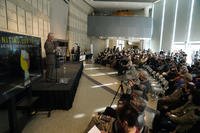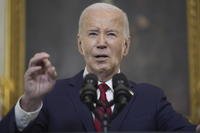The first F-35A Joint Strike Fighter jets will deploy to the Pacific this year, according to a top Air Force general.
"Our first operational squadron is scheduled for additional deployments this calendar year to include a Theater Security Package Deployment to Pacific Command," Maj. Gen. Jerry D. Harris Jr., the service's deputy chief of staff for strategic plans, programs and requirements, said in prepared testimony.
Harris testified before the House Armed Services subcommittee on tactical air and land forces on Thursday alongside Lt. Gen. Chris Bogdan, head of the F-35 Joint Program Office; Lt. Gen. Jon Davis, deputy commandant for Marine Corps aviation; and Rear Adm. Dewolfe "Chip" Miller III, the Navy's director of air warfare.
A squadron of the Corps' F-35B variant arrived in Iwakuni, Japan, last month. Japan's Air Self-Defense Force received its first F-35A recently, after it was presented during a ceremony at Luke Air Force Base, Arizona, in September. Japan intends to buy 42 Joint Strike Fighters.
The Air Force had been expected to send the first Theater Security Package of about a dozen F-35A jets to Europe.
In December, then-Air Force Secretary Deborah Lee James hinted that such a rotation would deploy to Europe amid security threats from Russia. She said after being approved to fly initial operations in August, the Lockheed Martin Corp.-made F-35 would be ready to deploy to the European theater next summer in line with how "allies expect it will transform the battlefield, even in the ... anti-access area denial environment," she said during an Atlantic Council event in Washington, D.C.
The prospect of a thaw in relations between the U.S. and Russia under a Trump administration dimmed this week after National Security Adviser Michael Flynn resigned Monday after admitting he "misled" Vice President Mike Pence about phone calls with a Russian diplomat before taking office.
An F-35 deployment to Europe is not necessarily out of the question. An Air Force spokeswoman confirmed to Military.com on Thursday the Air Force is also assessing its options to deploy the F-35 to the European theater as early as this summer as James had addressed.
Separately, the move to place aircraft in the Asia-Pacific region could signal President Donald Trump's intention to keep a more stern watch over China's increased buildup in the South China Sea, as well as North Korea, which recently launched another ballistic missile toward the Sea of Japan.
White House spokesman Sean Spicer in January addressed reports over Secretary of State Rex Tillerson's remarks that the U.S. would not stand for China's ramp-up of weapons and military airstrips in international waters.
"The U.S. is going to make sure that we protect our interests there," Spicer said, as reported by The Washington Post. "It's a question of if those islands are in fact in international waters and not part of China proper, then yeah, we're going to make sure that we defend international territories from being taken over by one country."
Defense Secretary Jim Mattis visited Japan and South Korea on his first trip overseas, in part to send a message to North Korea.
"It is a priority for President Trump's administration to pay attention to the northwest Pacific," Mattis said earlier this month.
"I am going to get current by listening to them, finding out where their issues are, and then we are going to work together and strengthen our alliance," he said.









